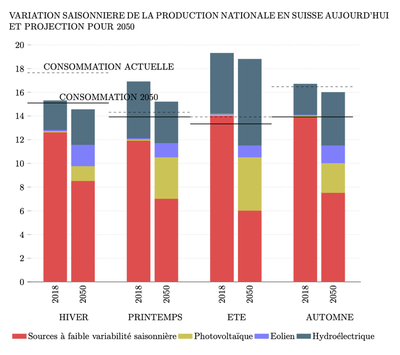Why do our electricity generation and consumption vary during the year, and why are they out of date?
Our production and consumption of electricity vary according to the seasons. Our indigenous electricity production peaks in summer, when run-of-river hydroelectric plants benefit from melting snow. In contrast, we consume more electricity in the winter, when we produce less. This seasonal disconnect is expected to intensify in the coming decades, as photovoltaic solar power, which generates more electricity in the summer, becomes more widespread.
92% of our domestic electricity production (more than 67 TWh in 2018 ^[not counting the 2.1 TWh of electricity generated by pumped storage [→ Q15].]) is generated by our hydroelectric facilities and nuclear power plants (37 TWh and 25 TWh respectively). The remaining 8% comes from incineration plants and small natural gas plants, and electricity generation from new renewable energies exceeded 3.7 TWh in 2017. It came mainly from photovoltaic solar energy (1.7 TWh), waste incineration plants (2 TWh, with electricity accounting for 50% as new renewable energy) and wind (0.1 TWh).
These annual values hide significant seasonal variability. In the summer half-year, Switzerland produces around 13% more electricity than during the winter half-year [→ see figure below]. This phenomenon is mainly the result of a large seasonal variation in river flows. In summer, river flows reach a maximum, due to melting snow. In winter, during the low-flow period, run-of-river generating stations produce nearly 50% less electricity than in summer. For example, in the hydrologic year 2017/18, the total winter production was 6.2 TWh, compared with 11 TWh in the summer.
For consumption, the situation is reversed [→ see figure below]. During the three winter months, we consume almost 30% more electricity than during the summer months, mainly due to electric heating [→ Q26]. The result of this seasonal imbalance between supply and demand is that we produce too much electricity on average from May to October, and not enough from November to April. Switzerland exports its summer surplus (between 2 and 7 TWh depending on the year) and currently makes up its winter deficit through imports (between 1 and 10 TWh).
With the increase in the number of solar photovoltaic installations, our summer production surplus is expected to increase in the coming decades [→ Q49]. The same will apply in the countries of Central Europe, which are also developing photovoltaic solar power.
Wind turbines produce more electricity in winter than in summer, because the wind blows more during the cold season. However, their potential in Switzerland remains far below that of run-of-river power plants and photovoltaics. Wind power will therefore not be enough to compensate for our winter deficit.
One way of reducing the seasonal mismatch between electricity supply and demand is to store the summer surplus until the following winter. The concept of "seasonal storage" will be one of the cornerstones of our future energy system [→ Q75]. Other solutions involve either the use of natural gas to produce electricity in winter or using imports [→ Q87].

References
- Kemmler, Spillmann & Koziel (2018)
- Kemmler, A., Spillmann, T. & Koziel, S. (2018). Ex-post-analyse des schweizerischen energieverbrauchs 2000-2017 nach bestimmungsfaktoren. Office fédéral de l'énergie (OFEN).
- Kemmler, A and Koziel, S and Wüthrich, P and Notter, B and Keller, M and Jakob, M and Catenazzi, G (2017)
- Kemmler, A and Koziel, S and Wüthrich, P and Notter, B and Keller, M and Jakob, M and Catenazzi, G (2017). Analyse des schweizerischen Energieverbrauchs 2000-2016 nach Verwendungszwecken. Office fédéral de l'énergie (OFEN).
- Office fédéral de l'énergie (OFEN) (2018)
- Office fédéral de l'énergie (OFEN) (2018). Statistique suisse de l’électricité 2018. OFEN.
- Veigl (2015)
- Veigl, S. (2015). Rapport annuel 2014 - Fondation Rétribution à prix coûtant du courant injecté RPC.